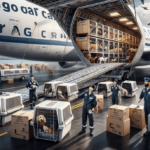Introduction to Shipping Live Fish with UPS
Shipping live fish is a delicate process that requires meticulous planning to ensure the well-being of the aquatic creatures during transit. Selecting a reliable shipping carrier is paramount to achieving safe and timely delivery. United Parcel Service (UPS) stands out as a preferred choice for many due to its comprehensive range of shipping services tailored for live animal transportation. This guide delves into UPS shipping rates for live fish, offering valuable insights and strategies to optimize costs while ensuring successful delivery.
Why Choose UPS for Live Fish Shipping?
Reliability and Experience
UPS is renowned for its dependable shipping services and extensive experience in handling live animal shipments. With a global network and advanced logistics capabilities, UPS ensures that live fish are transported under optimal conditions, minimizing stress and ensuring their safe arrival.
Tracking and Transparency
UPS provides robust tracking services that enable senders and recipients to monitor the progress of their shipments in real-time. This transparency offers peace of mind, allowing stakeholders to anticipate delivery times accurately and address any potential issues promptly.
Sustainability Initiatives
In addition to reliable services, UPS is committed to environmental sustainability. The company has implemented various eco-friendly practices, such as using alternative fuel vehicles and optimizing delivery routes to reduce its carbon footprint. By choosing UPS, customers support a company that prioritizes environmental responsibility.
Factors Influencing UPS Shipping Rates
Package Size and Weight
The dimensions and weight of the shipment are primary determinants of shipping costs. Larger and heavier packages incur higher rates due to increased handling and transportation requirements.
Destination and Distance
The shipping destination plays a crucial role in determining the cost. International shipments, especially to remote areas, are generally more expensive than domestic ones. Additionally, longer distances typically result in higher shipping fees.
Shipping Service Type
UPS offers various shipping services, each with different delivery speeds and costs. Services like Next Day Air and Two-Day Air are faster but come at a premium, whereas ground shipping is more economical but slower.
Seasonal Variations
Shipping rates can fluctuate based on seasonal demand. For example, the winter months may require additional packaging for temperature control, potentially increasing both the size and weight of the package and, consequently, the shipping costs.
Special Handling Requirements
Live fish shipments often require special handling, such as temperature control and expedited delivery, which can add to the overall shipping expenses.
Calculating and Reducing Shipping Costs
Using UPS Shipping Calculator
UPS provides an online shipping calculator that offers accurate cost estimates based on package details and destination. This tool allows users to compare different shipping options and select the most cost-effective service that meets their needs.
Optimizing Package Size and Weight
Reducing the size and weight of the package can significantly lower shipping costs. Consolidating multiple shipments into one package and using lightweight, durable packaging materials are effective strategies to minimize expenses.
Choosing the Right Shipping Service
Selecting a shipping service that aligns with the urgency of the delivery can help manage costs. While expedited services ensure quicker delivery, they are more costly. Assessing the criticality of delivery time can aid in selecting a service that balances speed and affordability.
Leveraging UPS Discounts
UPS offers various discounts for businesses and frequent shippers. Enrolling in programs like UPS My Choice or taking advantage of negotiated rates can result in substantial savings over time.
Preparing and Packaging Live Fish for Shipment
Proper Acclimation
Before shipping, it's essential to acclimate the fish to the shipping container. This involves placing them in a sealed bag with water and gradually adding water from the container to minimize stress. The bag should then be securely closed and placed in a larger bag with sufficient air.
Fasting Before Shipment
Fasting the fish for at least 24 hours before shipping helps reduce waste production, maintaining water quality and reducing the risk of ammonia buildup, which can be harmful during transit.
Secure Packaging
Use sturdy packaging materials to protect the fish from physical damage. Styrofoam containers with adequate insulation are ideal for maintaining temperature control. The outer box should include cushioning materials like packing peanuts or newspaper to absorb shocks.
Labeling and Instructions
Clearly label the package as containing live fish and include handling instructions. Providing detailed guidelines for the recipient on acclimating the fish to their new environment is crucial for the fish's well-being post-delivery.
Ensuring Temperature Control During Transit
Importance of Temperature Stability
Maintaining a stable temperature is critical when shipping live fish, as temperature fluctuations can cause stress or even be lethal to the creatures. Ensuring the appropriate temperature range during transit is paramount for their survival.
Temperature-Controlled Shipping Services
UPS offers temperature-controlled shipping options, such as Next Day Air Frozen and Next Day Air Cold, which are designed to maintain specific temperature ranges during transit. These services are essential for species that are sensitive to temperature changes.
Using Insulated Packaging Materials
Incorporate insulated materials like foam, gel packs, or dry ice into the packaging to help regulate the internal temperature. The choice of insulation depends on the external climate and the specific temperature requirements of the fish species being shipped.
Monitoring Temperature
Including a thermometer inside the shipment container allows for real-time monitoring of temperature conditions during transit. This proactive measure helps ensure that temperature-sensitive shipments remain within safe ranges.
Best Practices for Successful Delivery
Selecting a Reputable Shipping Partner
Partnering with a reliable and experienced shipping company like UPS enhances the likelihood of successful delivery. Experienced carriers are better equipped to handle the unique challenges associated with shipping live aquatic animals.
Scheduling Shipments Appropriately
Ship live fish early in the week to avoid weekend delays that could expose the shipment to extended periods without monitoring. Additionally, scheduling deliveries during business hours ensures prompt handling and reduces the risk of mishandling.
Communicating with Recipients
Maintain clear communication with the recipient to ensure they are prepared to receive and care for the fish immediately upon arrival. Providing shipment tracking information helps coordinate the timing of care and reduces stress on the fish.
Contingency Planning
Develop a contingency plan for potential issues such as weather disruptions or unexpected delays. Having alternative arrangements in place can mitigate risks and ensure the fish receive appropriate care throughout the shipping process.
Additional Resources
- UPS Shipping Live Animals
- American Fisherman - Live Fish Shipping Guidelines
- American Waterways Manufacturers Association - Best Practices
Conclusion
Shipping live fish is a complex endeavor that demands careful attention to detail and strategic planning. By choosing a reliable carrier like UPS, understanding the factors that influence shipping rates, and implementing best practices for preparation and packaging, senders can ensure the safe and cost-effective delivery of live fish. Incorporating temperature control measures and maintaining open communication with recipients further enhances the likelihood of successful shipments. With these strategies in place, the challenges of shipping live aquatic life can be effectively managed, ensuring the well-being of the fish and satisfaction of all parties involved.






















